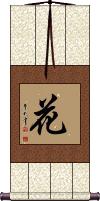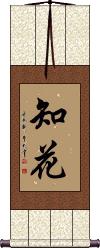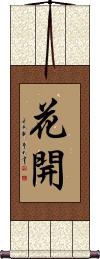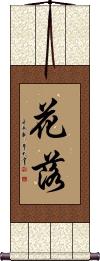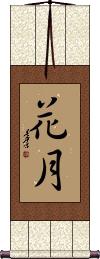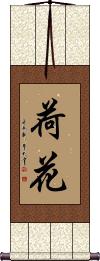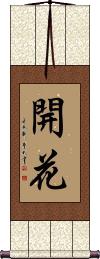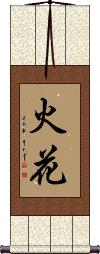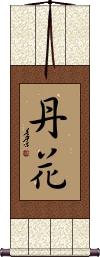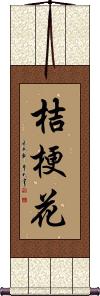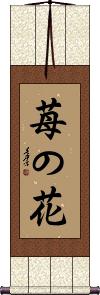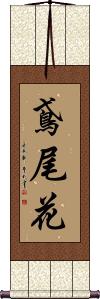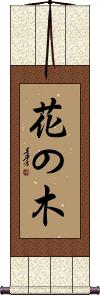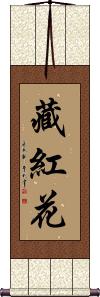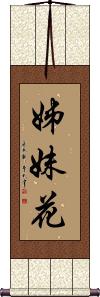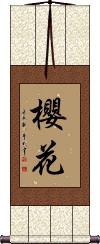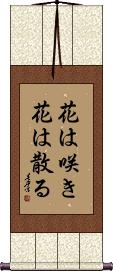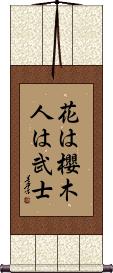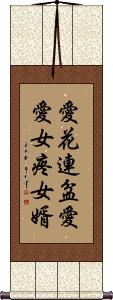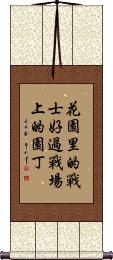Many custom options...
And formats...

花 in Chinese / Japanese...
Buy an 花 calligraphy wall scroll here!
Personalize your custom “花” project by clicking the button next to your favorite “花” title below...
1. Flower
2. Chikara
3. Flower Open / Blooming Flower
4. Flowers Fall / The End Comes
5. Kagetsu
6. Lotus
9. Red Flower
10. Azalea
11. Bellflower
12. Dahlia
14. Hua Mulan
15. Ichigo No Hana / Strawberry Flower
16. Ikebana
17. Iris Flower
18. Jasmine Flower
19. Magnolia Flower
20. Red Maple Tree
21. Saffron
22. Soul Sisters
23. Star Lotus
24. Cherry Blossom
25. Beauty of Nature
26. Flourish and Blossom Everywhere
27. Flowers Bloom and Flowers Fall
28. Flowers Bloom and Flowers Wither
29. Flower in the Mirror, Moon on Water
31. Orchid Queen
32. Flowers Bloom and Flowers Fall
33. In Flowers the Cherry Blossom, In Men the Samurai
34. Love the Flower, Love the Pot also
35. It is better to be a warrior in a garden than a gardener in a war
Flower
花 is the simple way to write “flower” in Chinese, Japanese, and old Korean.
It can also mean blossoms or can refer to a fancy or assorted pattern.
Note: In some contexts, it can mean “spend money.” However, as a single character, it will be read as a flower.
This has the meaning of Xochitl (flower) in Spanish, so if your name is Xochitl, I suggest this character to represent your name.
More random information about this character:
花 is the Korean surname spelled as “Hwa” before the Korean Romanization reformation of 2000-2001.
It's also a somewhat common given name in China (for females).
花 is a borrowed word from Chinese, so it sounds similar in Chinese and Korean.
Chikara
Flower Open / Blooming Flower
These two characters mean “flower open.”
花開 is also associated with Springtime, the beginning of something, or youth.
花開 is often followed by 花落 or “flower falls” (closes and loses its petals) which means “Things come and go” or “Youth comes and goes.”
If you like flowers and Springtime, this is a great selection for you. However, if you want the companion “flower falls” (flower withers), we offer that as a companion wall scroll or all together as a four-character phrase.
Flowers Fall / The End Comes
花落 means flower fall (closes and loses its petals).
It suggests nearing the end of something. A time that some might call “The sunset of life.” 花落 often follows 花開 or “flower open” to talk of the cycle of life.
We offer this as a possible companion to a “flower open” scroll (to be placed side by side or at either side of a doorway to say “things come and go” - a cool metaphor for a doorway). If placed in a doorway, it could be used to suggest to your guests that things bloom when they arrive through your door but wither when they leave (a great compliment).
Kagetsu
Lotus
荷花 is one of two ways to write/say “lotus” or “lily” in Chinese.
It will make a nice wall scroll if you are fond of lotus flowers and/or lotuses have a special meaning to you.
Opening / Blooming Flowers
開花 literally means opening flowers (a verb).
開花 is also associated with Springtime, the beginning of something, or youth.
If you like flowers and Springtime, this is a great selection for you.
In Korean Hanja, this can be a metaphor for achieving enlightenment or becoming civilized (blooming civilization).
Sparks / Sparkle
Red Flower
Azalea
Bellflower
桔梗花 means “Chinese bellflower” in Japanese.

桔梗花 is the three-character version of this title, which suggests that you are talking about the flower and not the medicinal herb derived from this kind of plant.
Dahlia
The Geisha’s World
花柳界 literally means “Flower Willow World/Kingdom.”
In Japanese, this means “The Realm of the Geisha” or “World of the Geisha.” I suppose there is a presumption that the Geisha is surrounded by flowers in their residence. In Chinese and Korean, this pretty much has colloquially come to mean “The Red Light District” or to refer to pimps, prostitutes, and johns as a group.
Hua Mulan
花木蘭 is the name of the famous Chinese woman warrior Hua Mulan.
She was made famous in the west by Disney's animated movie, “Mulan.”
Most of the historical information about her comes from an ancient poem. It starts with a concerned Mulan, as she is told a man from each family is to serve conscription in the army. Her father is too old, and her brother is too young. Mulan decides to take the place of her father. After twelve years of war, the army returns, and the best warriors are awarded great posts in the government and riches. Mulan turns down all offers and asks only for a good horse for the long trip home. When Mulan greets visiting comrades wearing her old clothes, they are shocked to find the warrior they rode into battle with for years is actually a woman.
Ichigo No Hana / Strawberry Flower
Ikebana
Iris Flower
鳶尾花 is the title for the iris flower in Chinese and Japanese.
If your name happens to be Iris, this is a beautiful way to express your name by meaning in both of these languages (it will mean your name but not sound like your name).
Can also mean wall iris, roof iris, or Iris tectorum.
Note: There are other titles for specific iris varieties - contact us if you need something special.
Jasmine Flower
Magnolia Flower
Red Maple Tree
Saffron
Soul Sisters
Star Lotus
星蓮花 is the title Star Lotus in Chinese.
For star lotus, some may write 星荷 instead - especially in Taiwan for reasons I am not sure of. 星荷 is sometimes romanized as “sing he” or “sing ho” though it would be “xīng hé” in mainland pinyin romanization. If you need a particular version or more info, please get in touch with me.
Cherry Blossom
櫻花 is how to write “cherry blossom” in Chinese and traditional Japanese Kanji.
The first character means “cherry” or sometimes “cherry tree.”
The second character means “flowers” or “blossoms.”
Oddly, my Chinese dictionary also defines these two characters as “Japanese oriental cherry tree” or “Oriental cherry blossom.” However, the first character is the only one that means “cherry,” so it can refer to any cherry blossoms in the whole world (not just those in Asia).
![]() There is an alternate version of the first character, which has become the standard for Japanese Kanji. If you want this version, instead of the one shown to the upper left, please click on the Kanji shown to the right instead of the button above. Although this is an alternate form in Chinese, most Chinese people will think this is just the Japanese version (Chinese people
don’t
necessarily know the history and all alternate forms of Chinese characters from the past). Therefore, this version shown to the right is best if your audience is Japanese (though most Japanese will recognize the form shown in the upper left).
There is an alternate version of the first character, which has become the standard for Japanese Kanji. If you want this version, instead of the one shown to the upper left, please click on the Kanji shown to the right instead of the button above. Although this is an alternate form in Chinese, most Chinese people will think this is just the Japanese version (Chinese people
don’t
necessarily know the history and all alternate forms of Chinese characters from the past). Therefore, this version shown to the right is best if your audience is Japanese (though most Japanese will recognize the form shown in the upper left).
Beauty of Nature
Ka-Chou-Fuu-Getsu
花鳥風月 is the Japanese Kanji proverb for “Beauties of Nature.”
The dictionary definition is “the traditional themes of natural beauty in Japanese aesthetics.”
The Kanji each represents an element of nature that constitutes beauty in traditional Japanese art and culture.
The Kanji breakdown:
花 = ka = flower (also pronounced “hana”)
鳥 = chou = bird (also pronounced “tori”).
風 = fuu = wind (also pronounced “kaze”).
月 = getsu = moon (also pronounced “tsuki”)
Flourish and Blossom Everywhere
Flowers Bloom and Flowers Fall
花開花落 is a complete proverb that lightly speaks of the cycle of life, or how things come and go in life.
This is used as a metaphor to suggest that youth is a temporary state that in time will pass.
This can also be used to suggest that fortunes can come and go (everything is temporary).
Note: There are two very similar versions of this proverb. The other uses a word that means wither instead of fall.
Flowers Bloom and Flowers Wither
花開花謝 is a complete proverb that lightly speaks of the cycle of life, or how things come and go in life.
This is used as a metaphor to suggest that youth is a temporary state, which in time, will pass.
This proverb can be used to suggest that fortunes can come and go (everything is temporary).
Note: There are two very similar versions of this proverb. The other uses a word that means fall instead of wither.
Flower in the Mirror, Moon on Water
鏡花水月 is an old Asian proverb that means “flowers in a mirror and the moon reflected in the lake” or “flowers reflected on a mirror and the moon reflected on the water's surface.”
Literally, 鏡花水月 reads “Mirror Flower, Water Moon.”
Figuratively this can be used to represent a lot of different ideas. It can be used to express an unrealistic rosy view or viewing things through rose-tinted spectacles. So you can use it to relay an idea about something that is visible but has no substance,
something that can be seen but not touched, or something beautiful but unattainable such as dreams or a mirage.
This expression is used to describe things like the subtle and profound beauty of poems that cannot be described in words.
鏡 = Mirror (or lens)
花 = Flower(s)
水 = Water
月 = Moon
Can also be written 水月鏡花 (just a slight change in word/character order).
No Rain No Flowers
Orchid Queen
Flowers Bloom and Flowers Fall
花は咲き花は散る is a Japanese proverb about the cycle of life, or how things come and go in life.
This can be used to suggest that youth, fortune, and life can come and go (everything is temporary).
Note: Because this selection contains some special Japanese Hiragana characters, it should be written by a Japanese calligrapher.
In Flowers the Cherry Blossom, In Men the Samurai
This Japanese proverb simply reads, “[In] Flowers it's Cherry Blossoms, [In] Men it's Warriors.”
花は櫻木人は武士 is meant to say that of all the flowers in the world, the cherry blossom is the best. And of all men in the world, the Samurai or Warrior is the best
This proverb has been around for a long time. It's believed to have been composed sometime before the Edo Period in Japan (which started in 1603).
Some will drop one syllable and pronounce this, “hana wa sakura hito wa bushi.” That's “sakura” instead of “sakuragi,” which is like saying “cherry blossom” instead of “cherry tree.”
The third character was traditionally written as 櫻. But in modern Japan, that became 桜. You may still see 櫻 used from time to time on older pieces of calligraphy. We can do either one, so just make a special request if you want 櫻.
Note: Because this selection contains some special Japanese Hiragana characters, it should be written by a Japanese calligrapher.
Love the Flower, Love the Pot also
Love Me, Love My Dog
This proverb, 爱花连盆爱爱女疼女婿, literally translates as “If one loves a flower, [one will] love its pot; [if one really] loves [one's] daughter, [one will also] love [one's] son-in-law.”
Figuratively, is similar to the English proverbs:
Love me, love my dog.
Love for a person extends even to the crows on his roof.
It is better to be a warrior in a garden than a gardener in a war
花園里的戰士好過戰場上的園丁 is the Chinese for the phrase, “It is better to be a warrior in a garden than a gardener in a war.”
This proverb is purported to come from the following exchange:
A student approaches his samurai master and says,
“Teacher, you instruct me how to fight, yet you preach to me about peace. How do I reconcile the two?”
The samurai responds,
“Because it is better to be a warrior in a garden than a gardener in a war.”
Mountain Travels Poem by Dumu
This poem was written almost 1200 years ago during the Tang dynasty.
It depicts traveling up a place known as Cold Mountain, where some hearty people have built their homes. The traveler is overwhelmed by the beauty of the turning leaves of the maple forest that surrounds him just as night overtakes the day, and darkness prevails. His heart implores him to stop, and take in all of the beauty around him.
First, before you get to the full translation, I must tell you that Chinese poetry is a lot different than what we have in the west. Chinese words simply don't rhyme in the same way that English or other western languages do. Chinese poetry depends on rhythm and a certain beat of repeated numbers of characters.
I have done my best to translate this poem keeping a certain feel of the original poet. But some of the original beauty of the poem in its original Chinese will be lost in translation.
Far away on Cold Mountain, a stone path leads upwards.
Among white clouds, people's homes reside.
Stopping my carriage I must, as to admire the maple forest at nights fall.
In awe of autumn leaves showing more red than even flowers of early spring.
Hopefully, this poem will remind you to stop, and “take it all in” as you travel through life.
The poet's name is “Du Mu” in Chinese that is: ![]()
![]() .
.
The title of the poem, “Mountain Travels” is: ![]()
![]()
You can have the title, poet's name, and even “Tang Dynasty” written as an inscription on your custom wall scroll if you like.
More about the poet:
Dumu lived from 803-852 AD and was a leading Chinese poet during the later part of the Tang dynasty.
He was born in Chang'an, a city in central China and the former capital of the ancient Chinese empire in 221-206 BC. In present-day China, his birthplace is currently known as Xi'an, the home of the Terracotta Soldiers.
He was awarded his Jinshi degree (an exam administered by the emperor's court which leads to becoming an official of the court) at the age of 25 and went on to hold many official positions over the years. However, he never achieved a high rank, apparently because of some disputes between various factions, and his family's criticism of the government. His last post in the court was his appointment to the office of Secretariat Drafter.
During his life, he wrote scores of narrative poems, as well as a commentary on the Art of War and many letters of advice to high officials.
His poems were often very realistic and often depicted everyday life. He wrote poems about everything, from drinking beer in a tavern to weepy poems about lost love.
The thing that strikes you most is the fact even after 1200 years, not much has changed about the beauty of nature, toils, and troubles of love and beer drinking.
Not the results for 花 that you were looking for?
Below are some entries from our dictionary that may match your 花 search...
| Characters If shown, 2nd row is Simp. Chinese |
Pronunciation Romanization |
Simple Dictionary Definition |
花 see styles |
huā hua1 hua ririka りりか |
More info & calligraphy: Flower(1) flower; blossom; bloom; petal; (2) cherry blossom; (3) beauty; (4) blooming (esp. of cherry blossoms); (5) ikebana; (6) (abbreviation) Japanese playing cards; (7) (the) best; (female given name) Ririka 華 puṣpa, a flower, flowers; especially the lotus, and celestial flowers. 花座 The lotus throne on which buddhas and bodhisattvas sit. |
丹花 see styles |
tanga たんが |
More info & calligraphy: Red Flower |
櫻花 樱花 see styles |
yīng huā ying1 hua1 ying hua sakura さくら |
More info & calligraphy: Cherry Blossom(female given name) Sakura |
火花 see styles |
huǒ huā huo3 hua1 huo hua hibana ひばな |
More info & calligraphy: Sparks / Sparklespark; (female given name) Hibana |
知花 see styles |
tomohana ともはな |
More info & calligraphy: Chikara |
花月 see styles |
hanatsuki はなつき |
More info & calligraphy: Kagetsu |
花開 花开 see styles |
huā kāi hua1 kai1 hua k`ai hua kai hanakai はなかい |
More info & calligraphy: Flower Open / Blooming Flowerflower opens |
荷花 see styles |
hé huā he2 hua1 ho hua |
More info & calligraphy: Lotus |
開花 开花 see styles |
kāi huā kai1 hua1 k`ai hua kai hua haruka はるか |
More info & calligraphy: Opening / Blooming Flowers(n,vs,vi) (1) flowering; blooming; blossoming; coming into bloom; (n,vs,vi) (2) flowering (of a civilization, talent, etc.); blossoming; blooming; bearing fruit (of efforts); (female given name) Haruka |
大麗花 大丽花 see styles |
dà lì huā da4 li4 hua1 ta li hua |
More info & calligraphy: Dahlia |
木蘭花 木兰花 see styles |
mù lán huā mu4 lan2 hua1 mu lan hua |
More info & calligraphy: Magnolia Flower |
杜鵑花 杜鹃花 see styles |
dù juān huā du4 juan1 hua1 tu chüan hua tokenka とけんか |
More info & calligraphy: Azalea(See サツキ・2) satsuki azalea (Rhododendron indicum); (given name) Tokenka |
生け花 see styles |
ikebana いけばな |
More info & calligraphy: Ikebana |
花の木 see styles |
hananoki はなのき |
More info & calligraphy: Red Maple Tree |
花木蘭 花木兰 see styles |
huā mù lán hua1 mu4 lan2 hua mu lan |
More info & calligraphy: Hua Mulan |
花柳界 see styles |
karyuukai / karyukai かりゅうかい |
More info & calligraphy: The Geisha’s World |
茉莉花 see styles |
mò li huā mo4 li5 hua1 mo li hua marika まりか |
More info & calligraphy: Jasmine FlowerArabian jasmine (Jasminum sambac); (female given name) Marika |
藏紅花 藏红花 see styles |
zàng hóng huā zang4 hong2 hua1 tsang hung hua |
More info & calligraphy: Saffron |
鳶尾花 鸢尾花 see styles |
yuān wěi huā yuan1 wei3 hua1 yüan wei hua |
More info & calligraphy: Iris Flower |
花鳥風月 see styles |
kachoufuugetsu / kachofugetsu かちょうふうげつ |
More info & calligraphy: Beauty of Nature |
遍地開花 遍地开花 see styles |
biàn dì kāi huā bian4 di4 kai1 hua1 pien ti k`ai hua pien ti kai hua |
More info & calligraphy: Flourish and Blossom Everywhere |
鏡花水月 镜花水月 see styles |
jìng huā shuǐ yuè jing4 hua1 shui3 yue4 ching hua shui yüeh kyoukasuigetsu / kyokasuigetsu きょうかすいげつ |
More info & calligraphy: Flower in the Mirror, Moon on Water(yoji) flowers reflected on a mirror and the moon reflected on the water's surface; something that is visible but having no substance; the subtle and profound beauty of poems that cannot be described in words |
花は桜木人は武士 see styles |
hanahasakuragihitohabushi はなはさくらぎひとはぶし |
(expression) (proverb) the best flowers are the cherry blossoms, the best individuals are the samurai; as the cherry blossom is first among flowers, so is the samurai first among men |
芲 花 see styles |
huā hua1 hua |
old variant of 花[hua1] See: 花 |
蘤 花 see styles |
huā hua1 hua |
variant of 花[hua1]; flower; blossom; also pr. [wei3] See: 花 |
一花 see styles |
himika ひみか |
(1) one flower; single flower; (noun - becomes adjective with の) (2) success; prosperity; (female given name) Himika |
七花 see styles |
nanaka ななか |
(female given name) Nanaka |
万花 see styles |
maka まか |
(female given name) Maka |
三花 see styles |
mihana みはな |
(female given name) Mihana |
上花 see styles |
uehana うえはな |
(surname) Uehana |
Click here for more 花 results from our dictionary
The following table may be helpful for those studying Chinese or Japanese...
| Title | Characters | Romaji (Romanized Japanese) | Various forms of Romanized Chinese | |
| Flower | 花 | hana | huā / hua1 / hua | |
| Chikara | 知花 | zhī huā / zhi1 hua1 / zhi hua / zhihua | chih hua / chihhua | |
| Flower Open Blooming Flower | 花開 花开 | huā kāi / hua1 kai1 / hua kai / huakai | hua k`ai / huakai / hua kai | |
| Flowers Fall The End Comes | 花落 | huā sà / hua1 luo4 / hua luo / hualuo | hua lo / hualo | |
| Kagetsu | 花月 | kagetsu | ||
| Lotus | 荷花 | hé huā / he2 hua1 / he hua / hehua | ho hua / hohua | |
| Opening Blooming Flowers | 開花 开花 | kai ka / kaika | kāi huā / kai1 hua1 / kai hua / kaihua | k`ai hua / kaihua / kai hua |
| Sparks Sparkle | 火花 | hibana | huǒ huā / huo3 hua1 / huo hua / huohua | |
| Red Flower | 丹花 | tan ga / tanga | ||
| Azalea | 杜鵑花 杜鹃花 | tokenka | dù juān huā du4 juan1 hua1 du juan hua dujuanhua | tu chüan hua tuchüanhua |
| Bellflower | 桔梗花 | ki kyou bana kikyoubana ki kyo bana | jié gěng huā jie2 geng3 hua1 jie geng hua jiegenghua | chieh keng hua chiehkenghua |
| Dahlia | 大麗花 大丽花 | dà lì huā da4 li4 hua1 da li hua dalihua | ta li hua talihua |
|
| The Geisha’s World | 花柳界 | karyuukai / karyukai | huā liǔ jiè hua1 liu3 jie4 hua liu jie hualiujie | hua liu chieh hualiuchieh |
| Hua Mulan | 花木蘭 花木兰 | huā mù lán hua1 mu4 lan2 hua mu lan huamulan | ||
| Ichigo No Hana Strawberry Flower | 苺の花 | ichigo no hana ichigonohana | ||
| Ikebana | 生け花 | ikebana | ||
| Iris Flower | 鳶尾花 鸢尾花 | ichi hatsu hana ichihatsuhana | yuān wěi huā yuan1 wei3 hua1 yuan wei hua yuanweihua | yüan wei hua yüanweihua |
| Jasmine Flower | 茉莉花 | ma ri ka / marika | mò lì huā mo4 li4 hua1 mo li hua molihua | |
| Magnolia Flower | 木蘭花 木兰花 | mù lán huā mu4 lan2 hua1 mu lan hua mulanhua | ||
| Red Maple Tree | 花の木 | hananoki | ||
| Saffron | 藏紅花 藏红花 | zàng hóng huā zang4 hong2 hua1 zang hong hua zanghonghua | tsang hung hua tsanghunghua |
|
| Soul Sisters | 姊妹花 | jiě mèi huā jie3 mei4 hua1 jie mei hua jiemeihua | chieh mei hua chiehmeihua |
|
| Star Lotus | 星蓮花 星莲花 | xīng lián huā xing1 lian2 hua1 xing lian hua xinglianhua | hsing lien hua hsinglienhua |
|
| Cherry Blossom | 櫻花 樱花 / 桜花 | ouka / oka | yīng huā / ying1 hua1 / ying hua / yinghua | |
| Beauty of Nature | 花鳥風月 | ka chou fuu getsu kachoufuugetsu ka cho fu getsu | ||
| Flourish and Blossom Everywhere | 遍地開花 遍地开花 | biàn dì kāi huā bian4 di4 kai1 hua1 bian di kai hua biandikaihua | pien ti k`ai hua pientikaihua pien ti kai hua |
|
| Flowers Bloom and Flowers Fall | 花開花落 花开花落 | huā kāi huā luò hua1 kai1 hua1 luo4 hua kai hua luo huakaihualuo | hua k`ai hua lo huakaihualo hua kai hua lo |
|
| Flowers Bloom and Flowers Wither | 花開花謝 花开花谢 | huā kāi huā xiè hua1 kai1 hua1 xie4 hua kai hua xie huakaihuaxie | hua k`ai hua hsieh huakaihuahsieh hua kai hua hsieh |
|
| Flower in the Mirror, Moon on Water | 鏡花水月 镜花水月 | kyou ka sui getsu kyoukasuigetsu kyo ka sui getsu | jìng huā shuǐ yuè jing4 hua1 shui3 yue4 jing hua shui yue jinghuashuiyue | ching hua shui yüeh chinghuashuiyüeh |
| No Rain No Flowers | 無雨無花 无雨无花 | wú yù wú huā wu2 yu4 wu2 hua1 wu yu wu hua wuyuwuhua | wu yü wu hua wuyüwuhua |
|
| Orchid Queen | 蘭花女王 兰花女王 | lán huā nǚ wáng lan2 hua1 nv3 wang2 lan hua nv wang lanhuanvwang | lan hua nü wang lanhuanüwang |
|
| Flowers Bloom and Flowers Fall | 花は咲き花は散る | hana wa sa ki hana wa chi ru hanawasakihanawachiru | ||
| In Flowers the Cherry Blossom, In Men the Samurai | 花は櫻木人は武士 花は桜木人は武士 | hana wa sakuragi hito wa bushi | ||
| Love the Flower, Love the Pot also | 愛花連盆愛愛女疼女婿 爱花连盆爱爱女疼女婿 | ài huā lián pén ài ài nǚ téng nǚ xù ai4 hua1 lian2 pen2 ai4 ai4 nv3 teng2 nv3 xu4 ai hua lian pen ai ai nv teng nv xu | ai hua lien p`en ai ai nü t`eng nü hsü ai hua lien pen ai ai nü teng nü hsü |
|
| It is better to be a warrior in a garden than a gardener in a war | 花園里的戰士好過戰場上的園丁 花园里的战士好过战场上的园丁 | huā yuán lǐ de zhàn shì hǎo guò zhàn chǎng shàng de yuán dīng huā yuán lǐ de zhàn shì hǎo guò zhàn chǎng shàng de yuán dīng ài wēng huā yuán lǐ de zhàn shì hǎo guò zhàn chǎng shàng de yuán dīng hua1 yuan2 li3 de zhan4 shi4 hao3 guo4 zhan4 chang3 shang4 de yuan2 ding1 hua1 yuan2 li3 de zhan4 shi4 hao3 guo4 zhan4 chang3 shang4 de yuan2 ding1 ai4 weng1 hua1 yuan2 li3 de zhan4 shi4 hao3 guo4 zhan4 chang3 shang4 de yuan2 ding1 hua yuan li de zhan shi hao guo zhan chang shang de yuan ding hua yuan li de zhan shi hao guo zhan chang shang de yuan ding ai weng hua yuan li de zhan shi hao guo zhan chang shang de yuan ding | hua yüan li te chan shih hao kuo chan ch`ang shang te yüan ting hua yüan li te chan shih hao kuo chan ch`ang shang te yüan ting ai weng hua yüan li te chan shih hao kuo chan ch`ang shang te yüan ting hua yüan li te chan shih hao kuo chan chang shang te yüan ting hua yüan li te chan shih hao kuo chan chang shang te yüan ting ai weng hua yüan li te chan shih hao kuo chan chang shang te yüan ting |
|
| Mountain Travels Poem by Dumu | 遠上寒山石徑斜白雲生處有人家停車坐愛楓林晚霜葉紅於二月花 远上寒山石径斜白云生处有人家停车坐爱枫林晚霜叶红于二月花 | yuǎn shàng hán shān shí jìng xiá bái yún shēng chù yǒu rén jiā tíng chē zuò ài fēng lín wǎn shuàng yè hóng yú èr yuè huā yuan3 shang4 han2 shan1 shi2 jing4 xia2 bai2 yun2 sheng1 chu4 you3 ren2 jia1 ting2 che1 zuo4 ai4 feng1 lin2 wan3 shuang4 ye4 hong2 yu2 er4 yue4 hua1 yuan shang han shan shi jing xia bai yun sheng chu you ren jia ting che zuo ai feng lin wan shuang ye hong yu er yue hua | yüan shang han shan shih ching hsia pai yün sheng ch`u yu jen chia t`ing ch`e tso ai feng lin wan shuang yeh hung yü erh yüeh hua yüan shang han shan shih ching hsia pai yün sheng chu yu jen chia ting che tso ai feng lin wan shuang yeh hung yü erh yüeh hua |
|
| In some entries above you will see that characters have different versions above and below a line. In these cases, the characters above the line are Traditional Chinese, while the ones below are Simplified Chinese. | ||||
Successful Chinese Character and Japanese Kanji calligraphy searches within the last few hours...
